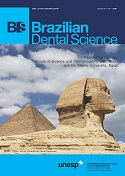Effect of age-related alterations on the biomechanics of teeth affected by non-carious cervical lesions
DOI:
https://doi.org/10.14295/bds.2019.v22i2.1654Resumo
Objective: The prevalence of non-carious cervical lesions (NCCLs) has increased in the recent years, especially in the elderly population. The successful prevention and treatment of those lesions requires an understanding of the biomechanics of aged teeth. Considering the importance of such aspect, the impact of the age-related dentin deposition on the stress distribution of NCCLs was evaluated by means of finite element analysis. Material and Methods: A 2-dimensional model of a sound maxillary first premolar was created using CAD software. Two tooth geometries (sound, aged) and two lesion shapes (wedge, saucer) were simulated to the model. The mesh was built with 35,000 triangle and square elements of 0.1 mm in length. All tissues were considered isotropic, homogeneous and linear. Occlusal surfaces were loaded with 300 N for simulating normal chewing forces. The stress distribution was analyzed by a color scale and by the maximum principal stress at the cavosurface line angle. Results: The aged models presented lower stress concentration in the overall system in comparison to sound models. The sharp angle of wedge shaped lesions promoted higher stress concentration at the center of cavosurface angle, favoring the lesions progression. Conclusion: Considering the limitations of the current methodology, it is possible to conclude that aged tooth is a more compact structure that can better respond to stress loadings. This protective intrinsic mechanism should be considered when adopting preventive and restorative measures for NCCLs for the elderly.
Keywords
Aging; Finite element analysis; Non-carious; Cervical lesions.
Downloads
Downloads
Publicado
Como Citar
Edição
Seção
Licença
TRANSFERÊNCIA DE DIREITOS AUTORAIS E DECLARAÇÃO DE RESPONSABILIDADE
Toda a propriedade de direitos autorais do artigo "____________________________________________________________________" é transferido do autor(es) para a CIÊNCIA ODONTOLÓGICA BRASILEIRA, no caso do trabalho ser publicado. O artigo não foi publicado em outro lugar e não foi submetido simultaneamente para publicação em outra revista.
Vimos por meio deste, atestar que trabalho é original e não apresenta dados manipulados, fraude ou plágio. Fizemos contribuição científica significativa para o estudo e estamos cientes dos dados apresentados e de acordo com a versão final do artigo. Assumimos total responsabilidade pelos aspectos éticos do estudo.
Este texto deve ser impresso e assinado por todos os autores. A versão digitalizada deverá ser apresentada como arquivo suplementar durante o processo de submissão.




























